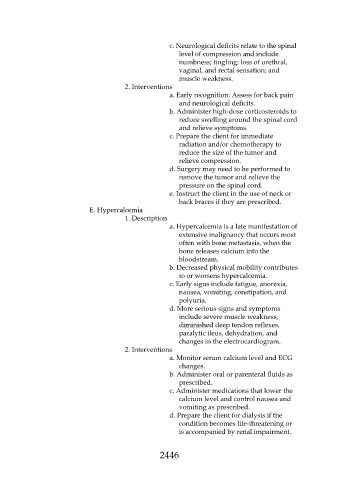Page 2446 - Saunders Comprehensive Review For NCLEX-RN
P. 2446
c. Neurological deficits relate to the spinal
level of compression and include
numbness; tingling; loss of urethral,
vaginal, and rectal sensation; and
muscle weakness.
2. Interventions
a. Early recognition: Assess for back pain
and neurological deficits.
b. Administer high-dose corticosteroids to
reduce swelling around the spinal cord
and relieve symptoms.
c. Prepare the client for immediate
radiation and/or chemotherapy to
reduce the size of the tumor and
relieve compression.
d. Surgery may need to be performed to
remove the tumor and relieve the
pressure on the spinal cord.
e. Instruct the client in the use of neck or
back braces if they are prescribed.
E. Hypercalcemia
1. Description
a. Hypercalcemia is a late manifestation of
extensive malignancy that occurs most
often with bone metastasis, when the
bone releases calcium into the
bloodstream.
b. Decreased physical mobility contributes
to or worsens hypercalcemia.
c. Early signs include fatigue, anorexia,
nausea, vomiting, constipation, and
polyuria.
d. More serious signs and symptoms
include severe muscle weakness,
diminished deep tendon reflexes,
paralytic ileus, dehydration, and
changes in the electrocardiogram.
2. Interventions
a. Monitor serum calcium level and ECG
changes.
b. Administer oral or parenteral fluids as
prescribed.
c. Administer medications that lower the
calcium level and control nausea and
vomiting as prescribed.
d. Prepare the client for dialysis if the
condition becomes life-threatening or
is accompanied by renal impairment.
2446

